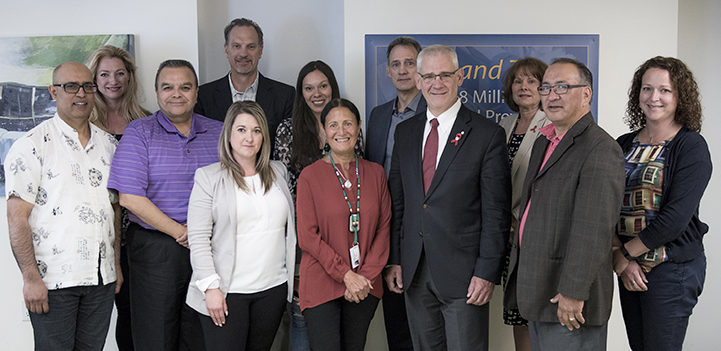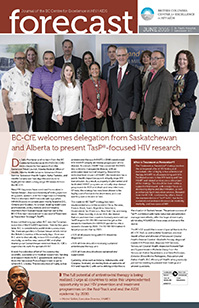
Dr. Julio Montaner and his team from the BC Centre for Excellence in HIV/AIDS (BC-CfE) were pleased to host guests from the Saskatoon Tribal Council, Alberta Medical Office of Health, Alberta Health Services, Saskatoon Police Service, Saskatoon Health Region, Kahui Taotoko, and Health Canada over two days this past June to highlight the latest cutting-edge HIV research from the BC-CfE.
New HIV diagnoses have continued to escalate in Saskatchewan, disproportionately affecting injection drug users, women, and the Indigenous community. This is a dramatic shift from a decade ago when HIV/AIDS cases in Canada were mostly found in B.C., Ontario and Quebec. As a result, leading health care professionals, policy makers, and community members from Saskatchewan reached out to the BC-CfE to learn more about its successful Treatment as Prevention Strategy (TasP®).
It was not that long ago when B.C. was the Canadian epicentre of the HIV/AIDS epidemic. Twenty-five years later, B.C. is considered a world-wide success story. Yet, there are parallels to Saskatchewan which mirror the British Columbia of those early days. How was B.C. able to dramatically reduce HIV morbidity and mortality, as well as new cases of HIV, and what learnings can Saskatchewan embrace from BC-CfE’s experience to curb the spread of HIV?
It took the collective effort of the community; scientific, academic and medical researchers; funding and support from the B.C. government; and buy-in from the Vancouver Police Department to get to where B.C. is today. The introduction of highly active antiretroviral therapy (HAART) in 1996 transformed HIV. HAART virtually eliminates progression of the disease. As a result, HAART has converted HIV/AIDS into a chronic manageable disease, with an anticipated near normal longevity. Beyond the individual level impact of HAART, the treatment has a public health impact because it virtually stops HIV transmission. As a result, a properly implemented and facilitated HAART program can virtually stop disease progression to AIDS and death and new infections. Of note, the strategy has now been shown to be highly cost effective in the short-term, and cost averting over a decade or two.
The made-in-BC TasP strategy has been implemented around the world in China, Panama, France, Brazil, Spain, Argentina, Swaziland, Queensland, San Francisco, New York City, and many more. More recently, in June 2016, the United Nations and member countries formally endorsed our TasP inspired 90-90-90 treatment target as the means to transform the HIV/AIDS pandemic into a sporadic disease by 2030. The 90-90-90 treatment target proposes that by 2020:
- 90% of all people living with HIV should be diagnosed
- 90% of them should be receiving sustained antiretroviral therapy, and
- 90% of them should achieve sustained viral suppression
Currently, cities such as Indiana, Indianapolis, and Glasgow, Scotland, are reeling from an epidemic of HIV and hepatitis C with some striking similarities to the situation in Saskatchewan. The proven success of TasP®, combined with harm reduction and addiction management efforts, offer the hope of eventually eliminating HIV/AIDS in these areas and around the world.
The BC-CfE would like to extend special thanks to the BC-CfE Staff, as well as Réka Gustafson, medical health officer and director of Vancouver Coastal Health Disease Control; Elizabeth Holiday, Regional Leader HIV Prevention, Regional HIV Services, Vancouver Coastal Health; Inspector Howard Tran and Superintendent Michelle Davey from the Vancouver Police Department; and Gina McGowan, Director, Blood Borne Pathogens, Population and Public Health, B.C. Ministry of Health; who graciously joined the meeting to present their findings and answer questions.

